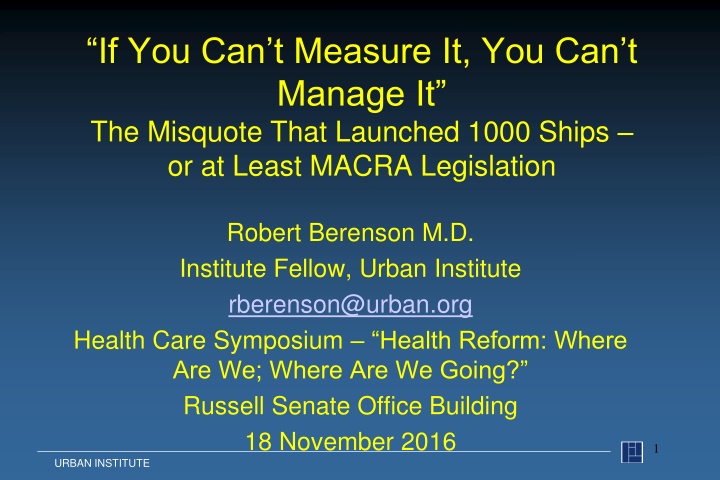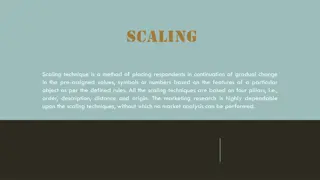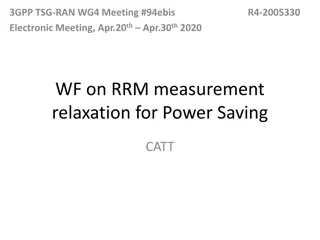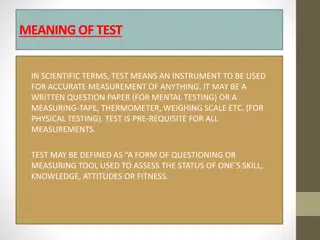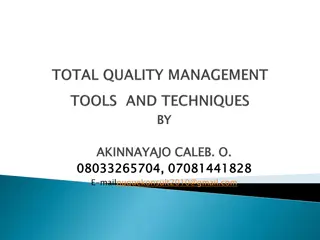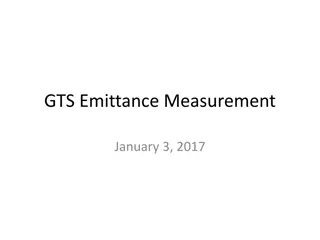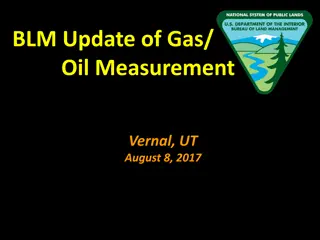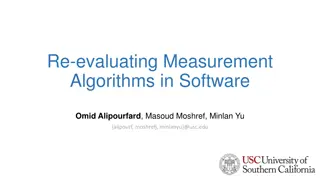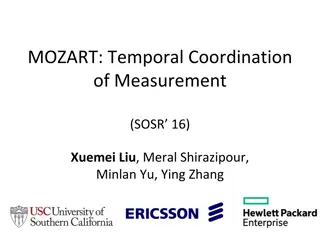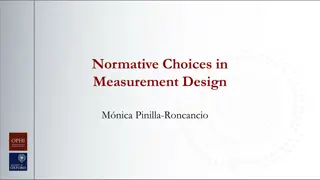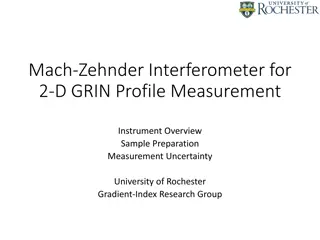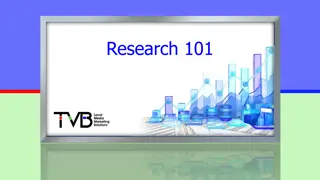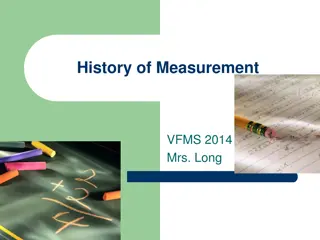Managing through Measurement - The Deming Misquote
Misattributed quote "If you can't measure it, you can't manage it" attributed to W. Edwards Deming, debunking its origins and implications in management practices. The importance of accurate quoting in evidence-based policy making is discussed, along with the distinction between public reporting, pay-for-performance, and quality improvement measures.
Download Presentation

Please find below an Image/Link to download the presentation.
The content on the website is provided AS IS for your information and personal use only. It may not be sold, licensed, or shared on other websites without obtaining consent from the author.If you encounter any issues during the download, it is possible that the publisher has removed the file from their server.
You are allowed to download the files provided on this website for personal or commercial use, subject to the condition that they are used lawfully. All files are the property of their respective owners.
The content on the website is provided AS IS for your information and personal use only. It may not be sold, licensed, or shared on other websites without obtaining consent from the author.
E N D
Presentation Transcript
If You Cant Measure It, You Cant Manage It The Misquote That Launched 1000 Ships or at Least MACRA Legislation Robert Berenson M.D. Institute Fellow, Urban Institute rberenson@urban.org Health Care Symposium Health Reform: Where Are We; Where Are We Going? Russell Senate Office Building 18 November 2016 URBAN INSTITUTE 1
If you cant measure it, you cant manage it And its close cousin, If something cannot be measured, it cannot be improved. Called a truism, the quote is commonly attributed to W. Edwards Deming, now deceased, a widely revered expert in management and management science 2 URBAN INSTITUTE
What Deming actually wrote and believed It is wrong to suppose that if you can t measure it, you can t manage it a costly myth. The New Economics, 1994, page 35. So not just taken out of context, but an overt, (intentional?) misquote Other consistent Deming quotes (of many available): The most important figures one needs for management are unknown or unknowable, but successful management must nevertheless take account of them. Out of the Crisis, 1982, p 121 Management by numerical goal is an attempt to manage without knowledge of what to do, and in fact is usually management by fear. Out of the Crisis, p. 76 3 URBAN INSTITUTE
Dueling slogans If you can t measure it, you can t manage it Not everything that can be counted counts, and not everything that counts can be counted. Commonly attributed to Albert Einstein, it was actually coined by a sociologist named William Bruce Cameron, writing after Einstein had died 4 URBAN INSTITUTE
No wonder we dont do evidence- based policy making We can t even get quotes right 5 URBAN INSTITUTE
One must distinguish measures for public reporting and P4P and for internal QI Of course, for QI, having performance data is often desirable or essential, e.g., hypertension For QI, one can be less rigorously accurate reputations are not at stake. Screen and verify The different purposes QI v P4P generate very different data sets, with little overlap My concern here is the public policy infatuation with P4P, not with how organizations use measures as part of QI to produce reliable processes (what Deming did care about) 6
P4P (MIPS) does increase value It is conceptually flawed because it crowds out intrinsic motivation that professionals have Testing to the test, while overall performance declines? Relevant and accurate measurement is difficult and very costly. Some problems, like many of the measure gaps, won t be fixed any time soon (despite MACRA expectations). The accumulating evidence on P4P across more than a dozen OECD countries finds no evidence that P4P in practice meets the compelling logic that P4P advocates assert 7 URBAN INSTITUTE
The public understandably does not rely much on ratings based on current measurement Four prominent hospital rating programs (not Consumers Reports) identified different sets of high performing hospitals with very few overlaps Each system uses its own rating methods, has a different focus to its ratings, and stresses different measures Austin, et al. Health Affairs, Mar. 2015 The ratings may have made good sense to the ratings producers, but what is the public supposed to make of it? In other economic sectors ratings are about performance that consumers understand and care about, relying on regulatory bodies to assure safety and address technical issues. This doesn t apply to health care. 8 URBAN INSTITUTE
The current policy infatuation with public reporting and, especially, P4P has lead to this perverse policy result: What we measure publically is considered important and demanding attention while What we can t or don t measure is marginalized or ignored altogether -- like diagnosis errors, a major, largely ignored, quality problem or workforce needs for an aging population 9 URBAN INSTITUTE
How to improve the use of measurement in public policy (from Berenson, Pronovost, and Krumholz ) Use measures strategically as part of major quality improvement initiatives, not as ends in themselves; Measure at the level of the health care system and then the organization, not the clinician ( information brokers do that); Expedite moving from processes to outcomes (but not easy); Place greater emphasis on patient experience and patient- reported outcome measures as important in themselves; Invest more in the basic science of measurement development, tasking a single entity with defining standards for measuring and reporting performance: to improve the validity and comparability of publicly-reported quality data and to anticipate and prevent unintended adverse consequences 10 URBAN INSTITUTE
The Medicare Access and CHIP Reauthorization Act of 2015 (MACRA) 11 URBAN INSTITUTE
Stabilizes fee updates Repeals SGR, averting a nearly 25% cut in fees July 2015-2019: Annual fee update 0.5%, 2020- 2025 0% Payment increases (and decreases) take place through MIPS After 2025: 0.25% update, but 0.75% if APM participation Before 2025, 5 percent bonuses for six years for physicians that qualify as participating in APMs with more than nominal risk Qualified medical homes count as APMs without risk Participants in APMs get out of the MIPS 12 URBAN INSTITUTE
The MACRA Quid Pro Quo for repeal of the Sustainable Growth Rate The actual substantial cost of the not reducing physician fees by >20% was paid for through a long-term schedule of nominal fee increases The quid pro quo the concept of moving from payment volume to value -- was not primarily about paying for the SGR fix, but rather about aspirationally desirable improvements in delivery There are two arms of the strategy the Merit- based Incentive Payment System and Alternative Payment Models clinicians (or their organizations) are given a choice 13 URBAN INSTITUTE
The Merit-based Incentive Payment System (MIPS) Combines the 3 current incentive programs: Physician Quality Reporting System (PQRS) quality Value-Based Modifier (VBM) quality & resource use Meaningful Use (EHR) Applies to payments after January 1, 2019 the current programs are in use till then and sun-setted Applies to all the types of health professionals receiving fee schedule $ s Excludes those with too few Medicare patients or Medicare revenues and those who have threshold level of payment through alternative payment methods May participate through EHR use, qualified clinical data registries and/or through group, virtual group or affiliation with a facility or hospital 14 URBAN INSTITUTE
MIPS assessment categories (percentages when fully phased in in 2022) Quality (30%) Resource Use (30%) Meaningful Use of EHRs (25%) Clinical Practice Improvement Activities (15%) Such as expanding practice areas, population management, care coordination, beneficiary engagement, patient safety 15 URBAN INSTITUTE
MIPS payment adjustments Negative adjustments capped Those at 0-25% of threshold get maximum negative adjustment 2019: 4% 2020: 5% 2021: 7% 2022: 9% Positive Maximum: 3 X annual cap for negative adjustment so theoretically as much as 27% more (I am not kidding) Eligible for additional payment if 25% above performance threshold But total is capped at $500 million / year (2019-2024) The negative adjustments fund the bonuses + the $500m 16 URBAN INSTITUTE
The food here is terrible -- and such small portions -- 1920 s Catskill s joke 17 URBAN INSTITUTE
What MACRA got right Repealing and paying (sort of) for the SGR repeal Combining three separate P4P programs into one (but functionally there now are four categories, each with measures to report, although fewer) Reducing the immediate financial impact of the MIPS with a phase in to the 9% or more rewards and penalties Including clinical practice improvement as a new component of accountability Promoting alternative payment models as the fundamental objective in the move from volume to value URBAN INSTITUTE 18
What MACRA got wrong It is numbingly complex, rewarding providers able to do game theory, and threatens small practice survival The timelines are overly ambitious and will lead to flawed APMs per capita costs in Medicare are as flat as ever at ~ GDP growth. Where s the fire? The idea that CMS can and should place a rating on each physician s value reflects Congressional overreach How does rewarding physicians with an extra 5% off the top add up to program savings when we don t have models that we know actually reduce spending? The complex of public reporting, P4P, and APM demos diverts attention from other opportunities to improve value 19
CMS deserves credit for the Oct.14 final MACRA Rules for: Exempting nearly 400,000 clinicians, most from small practices, with annual revenues of <$30,000 In year one, eliminating the resource cost component of the composite score Reducing, focusing and renaming the measurement requirements related to EHR adoption from Meaningful Use to Advancing Care Information Providing a transition year for clinicians effectively postponing the kick-off of data collection by 9 months, if so desired, and let clinicians experience the process Buying time so policy makers both in Congress and the new Administration can reconsider what they have wrought 20 URBAN INSTITUTE
CMS/LAN APM Framework 21 URBAN INSTITUTE
Some Observations About the CMS/LAN Framework Emphasizes theoretical incentives in payment methods, mostly ignoring the design and operational issues that working together influence clinician behavior Assumes that value derives only from 1) use of quality measures and 2) financial risk-bearing In short, the LAN Framework that classifies 28 payment is useful for presenting a continuum of payment method structural elements (measures and risk) but errs in implying that value follows the same continuum Any payment method can be designed to produce more or less value and that includes classic fee-for-service, in this case, the Medicare Physician Fee Schedule 22 URBAN INSTITUTE
Thanks 23 URBAN INSTITUTE
